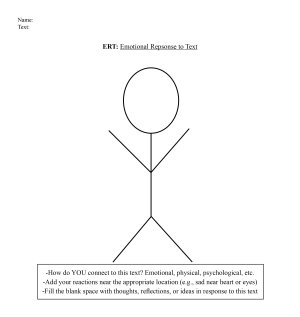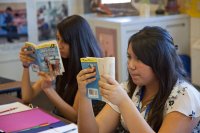Using Students’ Emotional Responses to Texts to Boost Literacy
Naming the emotions that a text evokes can make reading more personal for students and deepen their learning.
Your content has been saved!
Go to My Saved Content.A text of any genre has the potential to pull at your heart, fill you with laughter, or ignite your anger. If you find your interest piqued when you’re reading, the author has succeeded. Effective literature and expository texts often inspire empathy and utilize pathos to inform, persuade, or entertain the reader, and these texts should be used in literacy-based lessons in our classrooms to kick-start critical conversations and learning, and to build deeper mastery of literacy standards as students find stronger personal connections to what they read.
Emotional Response to Text
An approach I’ve developed called emotional response to text (ERT) helps readers of all ages and levels identify the feelings summoned by reading or listening to a text. I designed ERT to build on various literacy theories—e.g., reader-response theory; windows, mirrors, and sliding doors; narrative empathy—and a praxis that moves theory to practice.
To introduce ERT to your class, draw a stick figure like the one below on the board. Ask students to add words that represent sentiments near the body part that might create a more physical reaction to this emotional response. Here are some examples students might suggest as the class explores this approach.
- Brain: confusion, light-bulb idea, interest
- Eyes: tears for happiness or sadness
- Cheeks: embarrassment, anger
- Heart: excitement, love, sorrow, anxiety, yearning
- Armpits/Palms: sweat for nervousness
- Arms/Legs: goosebumps for fear
- Stomach: tension, nausea, hunger

Students may provide their own words to fill these in, but the goal is connecting to texts’ emotions and becoming aware of physical and psychological reactions. Analyzing emotional responses to texts also bridges social and emotional learning with academic content by making the content more personal—creating a stronger personal connection to increase students’ grasp of the information.
The Many Applications of ERT
After introducing the concept, we can use ERT to support other literacy concepts such as using quotations to support comprehension and identifying ways in which figurative language heightens readers’ emotions.
To incorporate ERT in a standards-based literacy lesson, pick a powerful text. I include some suggestions below. Provide students with something similar to the image above, or have them draw a stick figure on paper. After reading or listening to the text, students fill in the emotions they experience. This can be done as a whole-class discussion, with partners, or individually. When students fill in the emotions they are feeling, they not only create a tool to demonstrate their understanding—they also create fodder for further discussion of the text with peers or in subsequent assignments.
You might try it yourself first and write down the emotions you experience as you read the chosen text and provide that as a model for your students.
Here are examples of texts with powerful plots to guarantee a successful ERT the first time you try this with students.
Lower Elementary:
- Maddi’s Fridge by Lois Brandt and illustrated by Vin Vogel
- Separate Is Never Equal by Duncan Tonatiuh
Upper Elementary/Middle Grades:
- Brown Girl Dreaming by Jacqueline Woodson
- Mustaches for Maddie by Chad Morris and Shelly Brown
- Seedfolks by Paul Fleischman
Secondary/Young Adult:
- “The Lottery” by Shirley Jackson
- Night by Elie Wiesel
- I Am Alfonso Jones by Tony Medina and illustrated by Stacey Robinson and John Jennings
#OwnVoices (stories about characters from under-represented groups, written by people with similar experiences):
- El Deafo by Cece Bell
- George by Alex Gino
- American Street by Ibi Zoboi
- Internment by Samira Ahmed
Nonfiction/Other: Interviews, first-person point of view, primary resources, audio recordings, pictures
Expanding on ERT
ERT helps students make emotional connections to other literacy exercises, as well. You can modify the strategy for your particular groups of students by designing experiences that support their needs.
For lower elementary students, you can scaffold the use of ERT by starting with only an image of a head. You can provide your students with vocabulary lists, which exposes them to new words and supports correct spelling. You can also use technology (such as a drawing app) or provide an illustration of a body along with a list of words or images to move to corresponding locations.
To modify this lesson for secondary students, you might require students to include direct quotes or citations to represent emotions. You might also require sophisticated vocabulary (such as disheartened rather than sad). Robert Plutchik’s Wheel of Emotions might be helpful for this activity. Lastly, secondary students might compare texts to elicit contrasting emotional responses.
The more we acknowledge the emotions texts inspire, the more a text becomes personal—and the easier it is to write and talk about.
